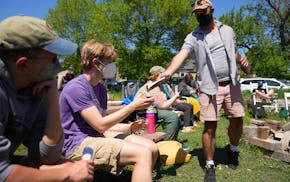Researchers found no evidence that the novel coronavirus has been seeping into wells or Minnesota's groundwater during a quick, emergency sampling project this summer.
The early findings are hopeful, but a much more thorough study is needed to determine any risk the virus may pose to drinking water, said Raymond Hozalski and Timothy LaPara, microbiologists with the University of Minnesota who are leading the project.
"So far we haven't found anything," LaPara said. "We need to get out there and start collecting more samples."
In June and July, the U took 30 large water samples from the Mississippi River, public and private wells and from St. Paul and Minneapolis water supplies. The well testing primarily focused on the southern and southeastern parts of the state, where the geology makes it more likely for certain contaminants to pass through porous rock to the groundwater.
Researchers believe that because the virus has been found lurking in septic systems and in raw sewage after infected people flush it down drains, it might eventually find its way into the groundwater by leaking through cracks in pipes or through the normal leaching of septic systems.
That wouldn't present a problem to much of the state, where groundwater in community wells is disinfected with chlorine or ultraviolet light, for example, and treated many times before it is ever used for drinking.
But it would pose a risk for people who rely on private wells and, to a lesser extent, to those who live in rural communities where water utilities don't disinfect water before it is piped to homes.
About one in five Minnesotans, or around 1 million people, rely on private wells for their water.
All wells and drinking water sources tested by the U were negative for both the novel coronavirus and for crAssphage, a harmless and more common virus researchers also checked for. Both viruses were found in local wastewater systems near the testing sites, researchers said.
The private wells were also clean of E. coli and the bacteria that cause Legionnaires' disease, Hozalski said.
Hozalski is hopeful the U will conduct a more full-scale study starting next year.
The preliminary research was paid for with $59,000 from the state's lottery-backed Environment and Natural Resources Trust Fund this spring, as part of an emergency grant to better understand how the virus acts.
The commission that helps decide how to spend the trust fund's dollars has recommended granting the U nearly $600,000 next year to conduct more than 100 well tests through a wider swath of the state.
Lawmakers still need to approve the funding.
Greg Stanley • 612-673-4882

Want to share info with the Star Tribune? How to do it securely

'Safe recovery sites' would offer syringes, naloxone and more to people using drugs. The plan could be in peril.
New Minnesota GOP leaders seek peace with party's anti-establishment wing

Who is Republican Lisa Demuth, Minnesota's first House speaker of color?

